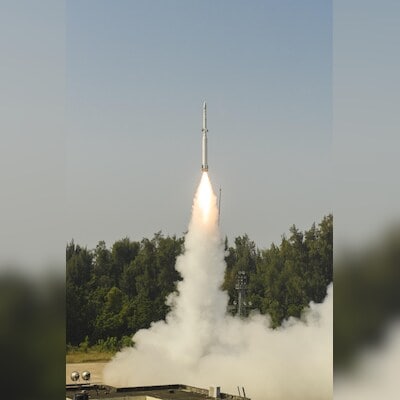)
DRDO Conducts Successful Maiden Flight-Test Of Phase-II Ballistic Missile Defence (BMD) Interceptor AD-1 Missile Off The Coast Of Odisha On November 2, 2022. Photo Credit: PIB
India also has a land-based, two-tier ballistic missile defence (BMD) system, similar to Israel’s Arrow Aerial Defence System that helped foil Iran’s attack on Tuesday involving nearly 200 ballistic missiles and the April assault that saw more than 300 missiles and drones being launched by Tehran.
Iran fired a salvo of ballistic missiles at Israel on Tuesday night, stating that it was retaliation for attacks that killed leaders of Hezbollah, Hamas, and the Iranian military, with the Israel Defense Forces (IDF) claiming that it had intercepted “a large number” of them.
Click here to connect with us on WhatsApp
The missile interceptions were carried out by Israeli and United States (US) missile defence systems. However, the IDF revealed that there were “isolated” impacts in central Israel and several more impacts in southern Israel.
Back in April, too, almost all of the more than 300 missiles and drones Iran launched at Israel failed to hit their targets, with 99 per cent of the projectiles being reportedly downed as Israel, the US, the United Kingdom (UK), and Jordan intercepted them before they got to Israel. Only “a small number” of ballistic missiles reached Israel, but did not cause any loss of life.
While Israel had help from its allies, particularly the US, in intercepting both these Iranian salvos, the foiling of these attacks once again highlights the sophisticated, multi-layered missile defence deployed by Israel.
In particular, Israel’s Arrow 2 and Arrow 3 systems, jointly developed with the US, were reportedly pressed into action during the April assault. The same systems were likely responsible for Israel’s share in downed Iranian missiles on Tuesday, though they were not explicitly mentioned in most reports.
Does India have its own ‘Arrow’?
India has also developed a land-based, two-tier BMD, with the Defence Research and Development Organisation (DRDO) having successfully completed a series of tests for the system in recent years.
The BMD system has been designed to track and destroy ballistic missiles, including those armed with nuclear warheads, both inside the earth’s atmosphere (endo-atmospheric interception) and outside it (exo-atmospheric interception).
While India’s missile interception capabilities have not been tested during an actual conflict, unlike Israel’s, they still represent a significant military achievement.
What do we know about India’s BMD programme?
India’s BMD programme has been divided into Phase-I and II, with the former designed to intercept missiles with a range of up to 3000 kilometres (km) and the latter aimed at missiles with a range of over 5000 km.
Under Phase-I, India has a two-tiered BMD system, consisting of the Prithvi Air Defence Vehicle (PAD)/Prithvi Defence Vehicle (PDV) and the Ashwin Advanced Air Defence (AAD) interceptors.
The PAD/PDV is meant for exo-atmospheric interception at altitudes between 50-180 km, while the AAD is designed for endo-atmospheric interception at altitudes between 20-40 km. Both these interceptors have undergone multiple successful tests.
When Phase-I of the BMD programme was completed in April 2019, media reports had said that a formal nod for the deployment of the system’s interceptor missiles was expected soon, with Phase-I covering Delhi and Mumbai.
As part of Phase-I, two indigenous long-range radars were also deployed to track incoming ballistic missiles.
A media report from December 2022 had revealed that a BMD radar site was being constructed at Udaipur, along with another site in Rajasthan and other such installations in Madhya Pradesh and Uttarakhand. These sites were slated to host long-range tracking radars called the Swordfish, which is an advanced variant of Israel’s Green Pine radar.
The first site was supposed to be completed in mid-2023 and the rest in 2024. Business Standard could not independently verify the status of these sites, which were reportedly meant to support the Phase-I BMD programme.
Under Phase-II of the BMD programme, two missiles, called AD-1 and AD-2, are being developed.
In November 2022, the DRDO conducted the successful maiden flight-test of the AD-1 interceptor missile. An official government release said that the flight-test was carried out with the participation of all BMD weapon system elements located at different geographical locations.
Designed as a long-range interceptor missile, the AD-1 is capable of both low exo-atmospheric and endo-atmospheric interception of long-range ballistic missiles and aircraft.
The AD-2 missile, which is under development, is meant to intercept intermediate-range ballistic missiles with a range between 3000-5500 km.
India is also developing a sea leg to its BMD system.
In April 2023, the DRDO and Indian Navy successfully conducted the maiden flight trial of a sea-based, endo-atmospheric interceptor missile off the coast of Odisha in the Bay of Bengal. According to an official release, the purpose of the trial was to elevate India into the elite club of nations that have naval BMD capability.
What do we know about Israel’s BMD system?
Israel operates a range of systems to intercept hostile projectiles, ranging from ballistic missiles to rockets and low-flying cruise missiles.
The intermediate rung is the David’s Sling, designed to intercept short- and medium-range threats.
The final rung is made up of the Arrow 2 and Arrow 3 systems, which have been jointly developed with the US.
According to the Center for Strategic and International Studies, the Arrow 2 is designed to destroy ballistic missiles in their terminal phase in the upper atmosphere. It has a range of 90 km and a maximum altitude of 51 km.
The Arrow 3, which employs hit-to-kill technology, is designed for exo-atmospheric interception of ballistic missiles — that is, it intercepts the missile in space, before it reenters the atmosphere.
Caption with image:
First Published: Oct 02 2024 | 5:06 PM IST
